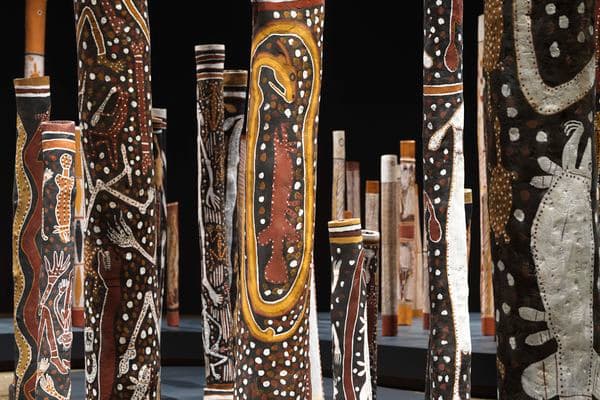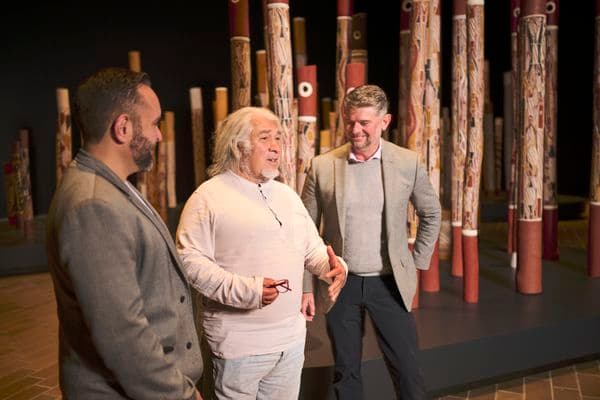Marrangu-Wurrkiganydjarr people

George Jangawanga, Marrangu people, Yarrpany story, yams, 1987-88, purchased with the assistance of funds from National Gallery admission charges and commissioned in 1987.
Key information
The Marrangu-Wurrkiganydjarr are people of the eucalyptus forest. Wurrkiganydjarr literally means flower power, and this group is also known as the sugarbag (honey) people.
Yarrpany, wild honey of the Dhuwa moiety, and Mewal, the honey ancestor, are depicted on many of the hollow logs by Jimmy Moduk, as are human figures, hives in trees and honey-collecting implements, such as stone axes, dilly bags, mops and ladles.
Bush creatures and features abound: bandicoots, wallabies, geckos, blanket lizards, goannas, flowers, trees, insects, stones and rocks. Many lagoon species are shown, such as salmon catfish, garfish, spangled perch, file snakes and water weed.
The path through the Memorial imitates the course of the Glyde River estuary which flows through the Arafura Swamp to the sea. The hollow log coffins are situated broadly according to where the artists' clans live along the river and its tributaries.

Jimmy Moduk, Marrangu people, Yarrpany story with lizard's young and mature frill-necked lizards and seaweed, 1987-88, purchased with the assistance of funds from National Gallery admission charges and commissioned in 1987.

Jimmy Moduk, Marrangu people, Yarrpany story with wallaby, 1987-88, purchased with the assistance of funds from National Gallery admission charges and commissioned in 1987.

George Jangawanga, Marrangu people, Yarrpany story, yams, 1987-88, purchased with the assistance of funds from National Gallery admission charges and commissioned in 1987.

Andrew Marrgululu, Marrangu people, Blackfish, 1987-88, purchased with the assistance of funds from National Gallery admission charges and commissioned in 1987.

Dick Smith Mewirri, Marrangu people, Djenbi story; goannas, Yarrpany (honey), 1987-88, purchased with the assistance of funds from National Gallery admission charges and commissioned in 1987.

Don Gundinga, Marrangu people, Eel-tailed catfish, blackfish, gasfish, 1987-88, purchased with the assistance of funds from National Gallery admission charges and commissioned in 1987.
Clan stories
Mewal — Dhuwa Honey
At the beginning of time, a Honey Spirit in the form of a man known by many names — Udal, Wuyal, Wandjuk, Mere and Mewal — came from the east near Blue Mud Bay and journeyed westward, hunting and gathering honey.
At Walkumbimirri near Ramingining, Honey Spirits were dancing and cutting down a tree, which fell and formed a creek. As the tree was cut, the wood chips flew hitting the earth and creating waterholes, one of which is now called Djapididjapin. The Honey Spirits metamorphosed into long rock beds which are riddled with holes. It is said that if you camp nearby, the humming sound of Honey Spirits can be heard at night.
Further along the creek Ngalkandji the Frill-necked Lizard, with a splinter caught in his throat, went into the ground at a large circular rock pool called Ngalkandjibimirri. South of there a Honey Spirit woman turned into a saddle shaped rock.
Wild honey, commonly known across Arnhem Land as 'sugarbag', is not only a delicacy but has ritual and spiritual significance. It becomes available in the dry season — Rrarrandharr — from August, when the gadayka or stringy-bark tree blossoms, to October. All creatures associated with these trees are sacred; geckos, goannas, frill-necked lizards, yams and bush wallabies.
In Arnhem Land species of bees are identified by the type of honey they produce and the location of their hives. Yarrpany honey stories are usually depicted quite naturalistically; the Dhuwa honey ancestors are shown with implements — such as axes, sticks, long-handled mops and bags — used to collect food and with yams which they planted for people to eat.
Wudubal — Marrangu Fish
In the wet season when the creeks and rivers are swollen, fish give birth to the next generation, many swimming inland to take advantage of abundant food.
At Ngoymuludjapin in Marrangu land a white grey rock is the Dreaming place for the Wudubal fish. Each year when the first rains come a ritual is performed in which pieces of this rock are thrown into the water, accompanied by songs and dances. This ensures the birth of the season's fish.











